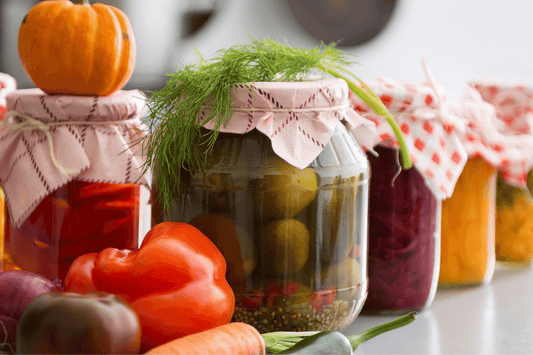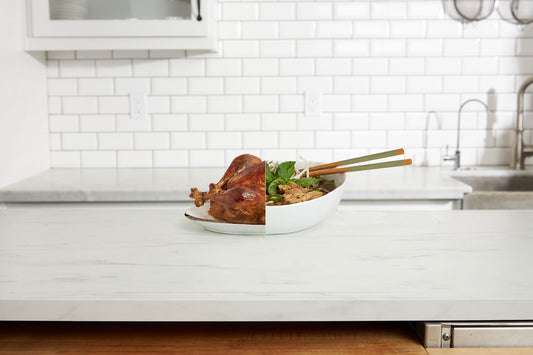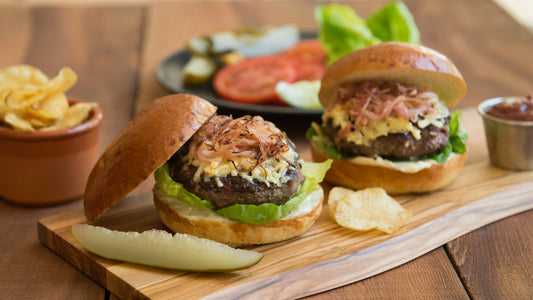This is a quick guide to achieving a great sear on sous vide proteins. If you love science as much as we do, look out for our deep dive into the physics of searing and preserving doneness in the Science Behind Searing Sous Vide Proteins guide.
When searing meat after sous vide cooking we want to maximize building color and texture while minimizing how much heat we are adding to our food. To do this we want to minimize how long our food is in contact with the pan, and we want to ensure all of the time is used to build color and texture.

Our first step is to ensure there is no excess moisture on our food. As a rule of thumb, the Maillard reaction (one of the key reactions in the browning process) really begins to pick up speed above 250°F, which is significantly hotter than the temperature that water boils [212°F]. So if there is any residual moisture left on the food, it will all have to boil away before our food can brown.
Speaking of the Maillard reaction, the key components of this chemical reaction are proteins and sugars. Wherever these two are present, along with heat and time, we are going to build beautiful brown flavors. We can use this knowledge to expedite the browning process by adding extra proteins and sugars to the mix. The way we accomplish this is by using butter. Butter is an emulsion of fats, sugars, proteins, and a little bit of water. When we use this to sear the additional butter solids, will add fuel to the Maillard fire (so to speak) and we will end up with a darker and tastier result.
Sadly, we can only use this hack when we sear for a relatively short amount of time. All of this extra fuel speeds up the transition from browning to burning. So, when we need to spend more time building texture, we need to stick with oil.

Oil has its own constraints too. If you have spent any time looking up oil smoke points, which you can do in our oil guide, you may have noticed that most oils cannot sustain being heated above 500°F (260°C). This is because the oils will break down, burn, smoke, and possibly catch fire, all of which is neither tasty nor safe. This creates an upper limit for searing. We want to use the oil with the hottest smoke point, and ride the thin line between as hot as possible and too hot. Luckily with Cue’s temperature control this becomes infinitely easier.
For a quick-do-it-yourself sear, the normal technique is to get a pan “ripping hot”, add oil, then meat, and try to build enough color before smoking yourself out of the kitchen. With Cue, we can cut out the smoking step :-)
General Sous Vide Sear Technique
First, find the highest temperature oil you have in your home, bring the pan up to the maximum temperature of that oil. Learn more about cooking oils with our Complete Guide to Cooking Oils. While the pan is preheating, add a few tablespoons of oil. By doing this, the pan will ensure the oil stays right on the edge of its smoke point, AKA as hot as possible to get a tasty sear with no fear.
Once your pan and oil are hot, add your thoroughly dried protein and sear until you achieve a good crust and color. When you add your protein the burner is going to respond to the relatively cool temperature of the meat and ramp up the power to recover the temperature. This quick response keeps the pan as hot as possible during the whole sear. Since the pan is as hot as possible, the meat will get the most sear and color in the least amount of time!

Specific Sous Vide Sear Techniques
Now that we have covered the basics, let’s walk through our Chef’s preferred techniques which use a little more nuance and panache!
Pro Tips For Searing Beef, Pork, etc.
- For Beef, Pork, etc. you can get a darker sear and a better crust by ”starting earlier”. Pre-sear your meat before you put it in the bag. This will help develop more flavors and texture when you sear after Sous Vide.
-
For cuts where you want even more texture try searing for 30 seconds on each side, 2 times each. This will actually build more color than just doing 1 minute on each side once.

Step by Step for Beef, Lamb, and Venison
Ingredients
Sous vide Beef, Lamb or Venison
2 tbsp Butter
- Using the Cue app, set your Cue smart induction burner to 445° F (229° C) or if using a standard cooktop, set your stove to medium-high.
- Add the butter to the pan.
- Using a paper towel dry your proteins thoroughly.
- Once your pan is preheated, sear your meat for 1 minute on each side.
- When finished remove from the pan and allow to rest if desired.
Step by Step for Pork and Veal
We are using a moderate sear temperature because we don’t want these proteins to have a blackened crust, we want something closer to brown
Ingredients
Sous vide Pork or Veal
2 tbsp Butter
- Using the Cue app, set your Cue smart induction burner to 435° F (223° C) or if using a standard cooktop, set your stove to medium-high.
- Add the butter to the pan.
- Using a paper towel dry your proteins thoroughly.
- Once your pan is preheated, sear your meat for 1 minute on each side.
- When finished remove from the pan and allow to rest if desired.

Pro Tips For Searing Fish
- Dry the fish skin super well
- Don’t move the fish for at least 1 minute, you need to allow time for the skin to crisp, it will naturally release from the pan
Step by Step for Skin-on Salmon (or other fish)
Ingredients
Sous vide skin-on Salmon
3 tbsp Oil
- Using the Cue app, set your Cue smart induction burner to 450° F (232° C) or if using a standard cooktop, set your stove to medium-high.
- Add the oil to the pan.
- Using a paper towel dry your fish thoroughly.
- Once your pan is preheated, sear the skin for 2 minutes pressing down lightly to ensure contact.
- Flip and sear the second (flesh side) for 30 seconds.
- When finished remove from the pan and allow to rest if desired.
Step by Step for Skinless Salmon (or other fish)
Ingredients
Sous vide skinless Salmon
3 tbsp Oil
- Using the Cue app, set your Cue smart induction burner to 425° F (218° C) or if using a standard cooktop, set your stove to medium-high.
- Add the oil to the pan.
- Using a paper towel dry your fish thoroughly.
- Once your pan is preheated, sear the fish for 2 minutes pressing down lightly to ensure contact.
- Flip and sear the second side for 30 seconds
- When finished remove from the pan and allow to rest if desired.

Pro Tips For Searing Chicken and Duck
For skin on Chicken and Duck, you can get a crispier skin by rendering the skin before you bag it.
- Lightly score the skin and place the meat skin side down in a cool pan. Then set the temperature to 300°F and allow the skin to render.
- Pour off any fat that accumulates in the pan. After 5 to 20 minutes you should have a good amount of fat reserved.
- Bring the pan up to 385°F to produce some color then cool your bird, bag it, tag it, and give it a bath! Now when you sear it, you will have a crunchy-er crust.
Step by Step for Skin-on Chicken and Duck
Ingredients
Sous vide skin-on Chicken or Duck
3 tbsp Oil
- Using the Cue app, set your Cue smart induction burner to 435° F (223° C) or if using a standard cooktop, set your stove to medium-high.
- Add the oil to the pan.
- Once your pan is preheated, sear the first side for 3 minutes pressing down lightly to ensure contact.
- Flip and sear the second side for 30 seconds
- When finished remove from the pan and allow to rest if desired.
Step by Step for Skinless Chicken
Ingredients
Sous vide skinless Chicken
3 tbsp Oil
Flour as needed
- Using the Cue app, set your Cue smart induction burner to 435° F (223° C) or if using a standard cooktop, set your stove to medium-high.
- Add the oil to the pan.
- While your pan is preheating, dust one of your chicken lightly with flour.
- Once your pan is preheated, sear the floured side for 2 minutes pressing down lightly to ensure contact.
- Flip and sear the second side for 30 seconds
- When finished remove from the pan and allow to rest if desired.
Download the Hestan Cue app for iOS and Android for tips & tricks from the pros, video-guided recipes, and precise temperature cooking on Cue.
If you found this guide helpful, please let us know–we would love to hear your feedback. Keep us posted with photos of your experiments and share your results and #CueTips with the Hestan Cue Community!




